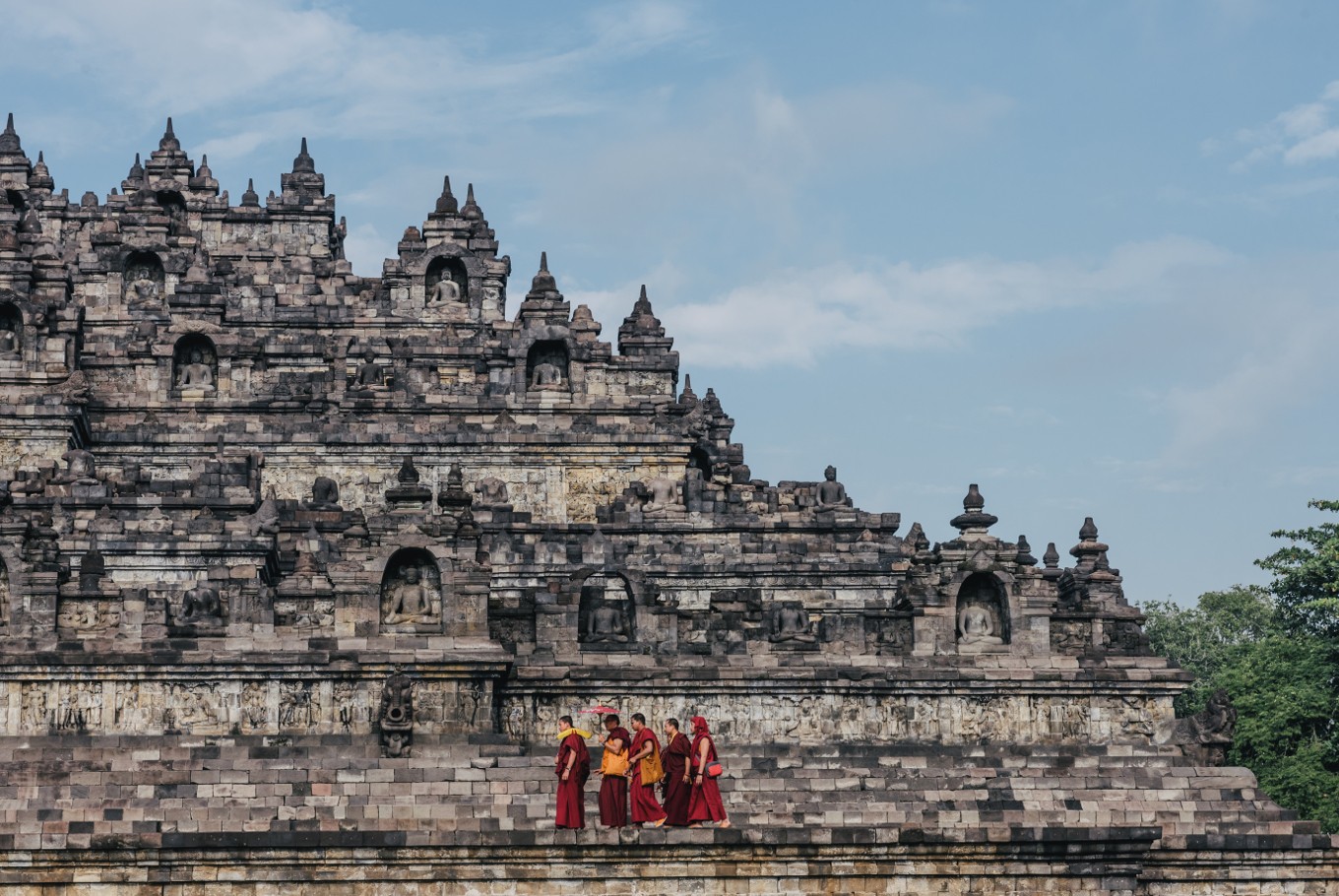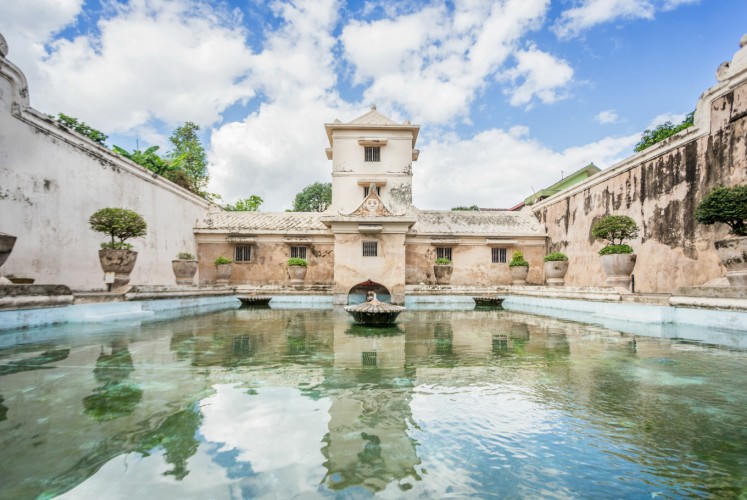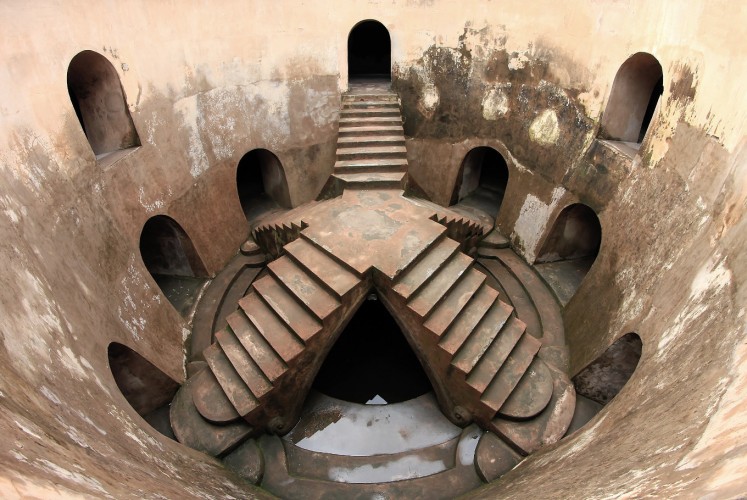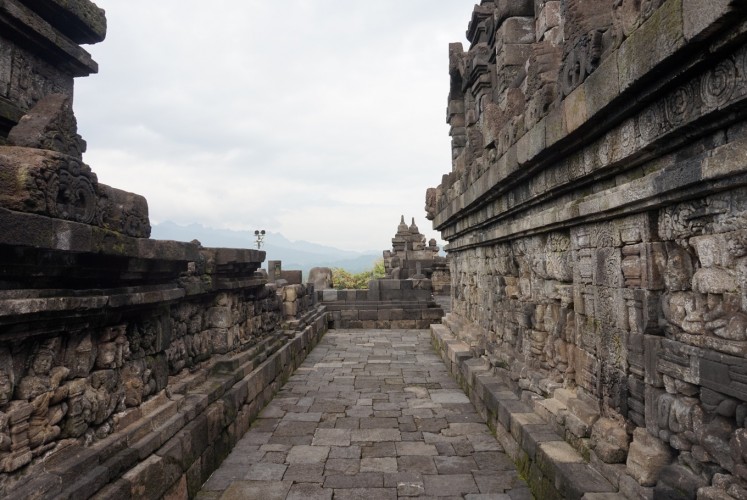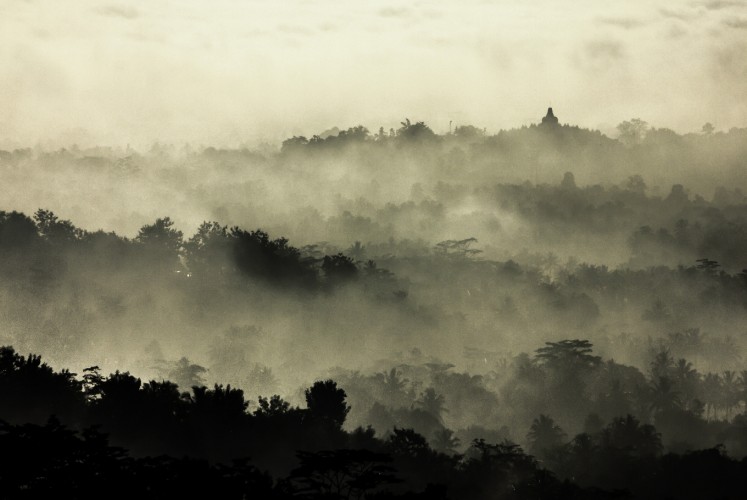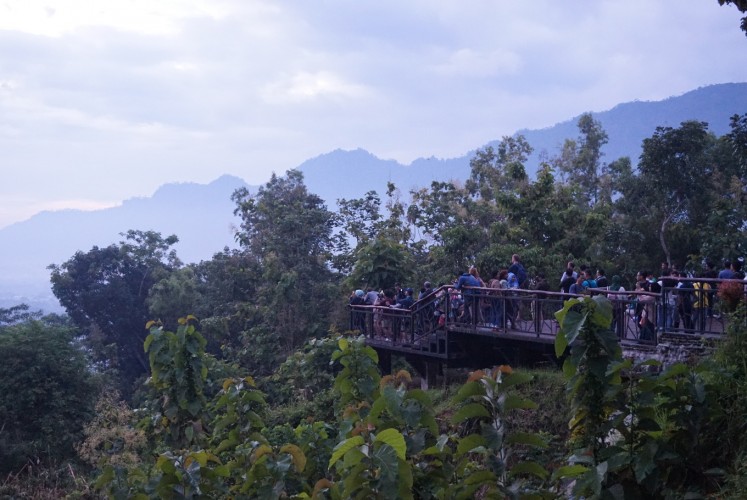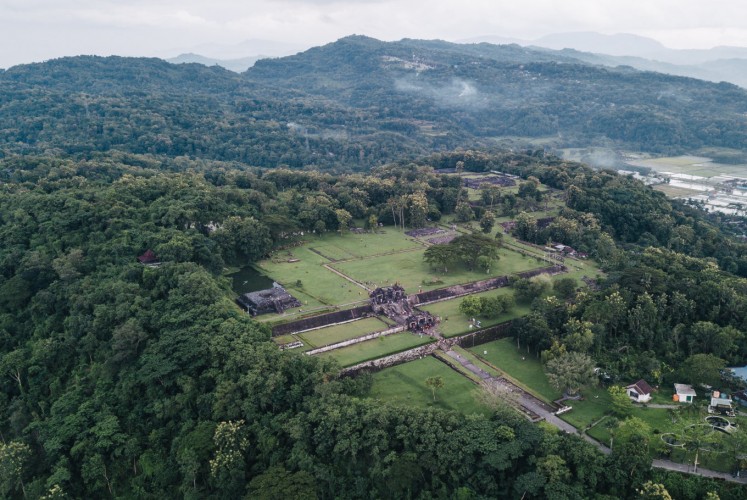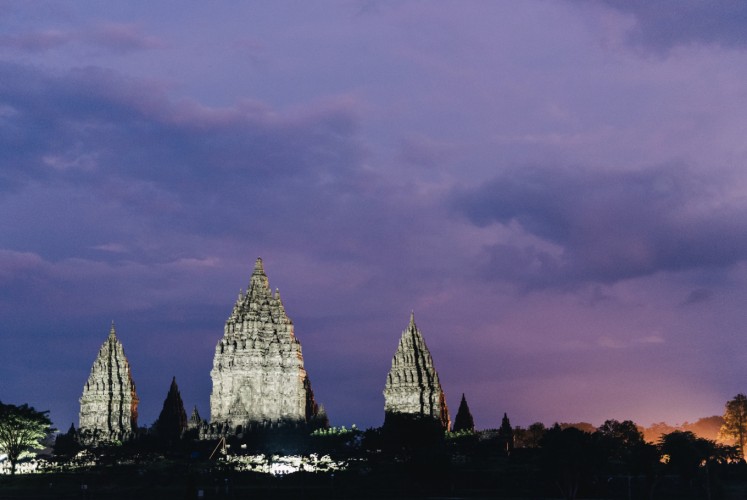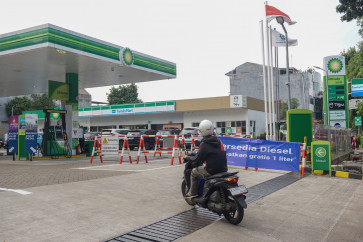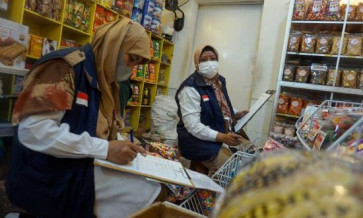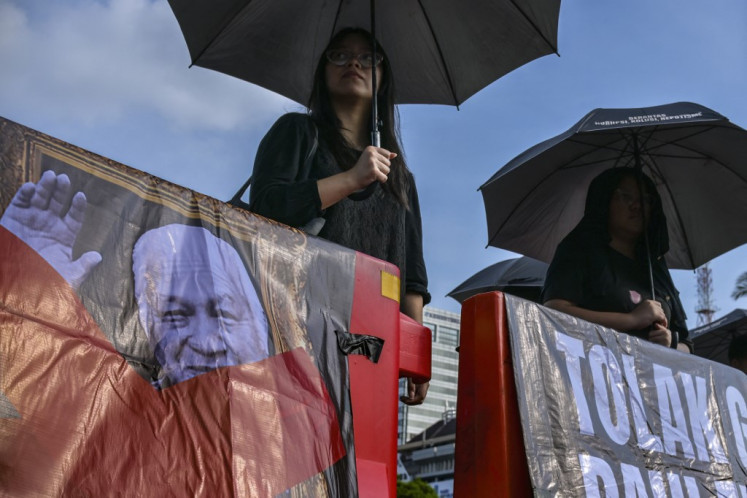Popular Reads
Top Results
Can't find what you're looking for?
View all search resultsPopular Reads
Top Results
Can't find what you're looking for?
View all search resultsJakpost explores Yogyakarta
Often recognized as the center of intellectuals and historical places, Yogyakarta has its own charms that attract local and foreign travelers alike. Here are the things that you should not miss in the city.
Change text size
Gift Premium Articles
to Anyone
O
ften recognized as the center of intellectuals and historical places, Yogyakarta has its own charms that attract local and foreign travelers alike. Here are the things that you should not miss in the city:
How to get there
By air
Located in Sleman regency, Adisutjipto International Airport is Yogyakarta’s only airport that caters to airlines like Garuda Indonesia, Batik Air, Citilink, Lion Air and Sriwijaya Air. Those coming from Singapore and Kuala Lumpur can reach Yogyakarta by direct flight with AirAsia or via connecting flights from other airports, such as Soekarno-Hatta International Airport in Cengkareng, Banten, and Ngurah Rai International Airport in Denpasar, Bali. The flight time from Soekarno-Hatta International Airport is usually around an hour.
Soon Yogyakarta will have a new international airport in Kulonprogo that is expected to begin operating in 2019.
By land
Many visitors also travel to Yogyakarta by train from Jakarta's Gambir Station or Pasar Senen Station. The trains operate daily with the trip duration from seven to eight hours.
Mainly set for executive and business trains, Yogyakarta or Tugu Station is more strategic as it is located near the famous Jl. Malioboro. The station also serves air-conditioned economy trains coming from Pasar Senen Station.
Meanwhile, the regular economy class trains coming from Pasar Senen Station arrive at Lempuyangan Station, located not far from Tugu Station.
Bus is another option to go to Yogyakarta, but the trip usually takes longer compared to trains, which is from nine to more than 10 hours from Jakarta depending on the traffic. The buses in Jakarta mostly leave from Lebak Bulus in South Jakarta or East Jakarta; therefore it is best to check the bus operator about the departure location. Some of the buses that travel to or make a stop in Yogyakarta are Santoso, Handoyo and Pahala Kencana.
The Giwangan bus stop in Bantul regency is the largest bus stop in the province, but there are also Jombor and Wates bus stops for visitors aiming to visit Yogyakarta.
Best times to visit
The right time to visit Yogyakarta actually depends on your travel itinerary. If your vacation is mostly spent outdoors, it is better to travel during the dry season from May to October. This also applies for those who seek the sunrise and sunset in some tourist destinations in Yogyakarta, such as Punthuk Setumbu, Plaosan Temple and Ratu Boko Temple.
However, if the city’s cultural scene is what you're aiming for, you may want to mark your calendar — Ramayana Ballet Prambanan show in an open theater runs from May to October and the annual Grebeg Syawal ritual is held in conjunction with Idul Fitri celebrations, estimated to be celebrated from June 14 to 16.
Climate
Just like other provinces in Indonesia, Yogyakarta has two seasons — wet and dry.
Popular areas
Malioboro
Travelers walk down the sidewalk of Malioboro. (Marriott International/Kurniadi Widodo)Known as the busiest shopping street in Yogyakarta, Maliboro is the right place to taste traditional dishes and shop for batik and other souvenirs. The one-way street is alive 24 hours a day, extending for about 2 kilometers from north to south.
For those who are not too keen on exploring Malioboro by foot, becak (pedicabs) and bentor (a portmanteau of becak and motorcycle) are available throughout the street to take you around the area. Many of the drivers also can be your guide about tourist destinations in Yogyakarta, especially to find bakpia (full moon-shaped pastry) establishments. Sometimes they can even take you farther to Yogyakarta Palace. The tariff for becak starts from Rp 25,000 (US$2) to Rp 30,000.
Visit this place on weekdays as Malioboro is known to be crowded on weekends.
Located near Malioboro, there is also Pasar Beringharjo (Beringharjo Market) for people looking for all types of batik.
Kraton Ngayogyakarta Hadiningrat
"Golek Ayun-Ayun", one of the dances performed at the Royal Palace on Sunday. (JP/Ni Nyoman Wira)Kraton Ngayogyakarta Hadiningrat is the palace of the sultan of Yogyakarta. Visitors have to explore the area by foot and guides are available inside the palace.
The palace has two alun-alun (town square) — south and north. Alun-alun Kidul (south town square), is like a magnet for people, especially in the evening, because it is where street food vendors flock to and entertainment events are held. It also has two giant beringin (banyan) trees and, according to legend, your wish will be granted if you can pass through the space between both trees with your eyes closed.
Many of the cultural events in Yogyakarta are held at the palace, including Grebeg Syawal and Sekaten. Those who visit the palace can enjoy dances and music performances daily at Bangsal Sri Manganti. On Mondays and Tuesdays visitors can enjoy gamelan performance, while on Wednesdays there is a Javanese golek (traditional puppet) dance performance. Moreover, Thursdays and Sundays are for dance performances, while Fridays are for mocopatan (Javanese verse accompanied by traditional music) performed by abdi dalem (royal servants). On Saturdays, a wayang kulit (shadow puppet) performance is usually held.
The performances usually start at 9:30 a.m., but it is better to come early to get a seat.
The entrance fee for foreign tourists starts from Rp 15,000 with an additional Rp 1,000 fee for cameras.
Taman Sari
One of the pools at Taman Sari Water Park. (Marriott International/Kurniadi Widodo)Situated inside the Keraton Royal Palace area, Taman Sari Water Castle functioned in the past as the vacation and relaxation place for the royals. It has swimming pools as well as a separated pool for the king, dressing rooms and a sauna room. From here, people will also able to visit the underground mosque that only has one door for both entrance and exit. The entrance fee for foreign tourists starts at Rp 15,000 and guides are available.
The inner part of the underground mosque (Marriott International/Kurniadi Widodo)Prambanan
According to UNESCO, the Prambanan, or Roro Jonggrang temple, was built in the ninth century. The largest Hindu temple complex in Indonesia has relief of Ramayana and one of the popular tourist spots is the Durga Mahisasuramardini statue.
Read also: Jakpost explores Bali
Borobudur
One of the alleys at Borobudur Temple in Magelang, Central Java. (JP/Ni Nyoman Wira)Widely known as the largest Buddhist temple, Borobudur is actually located in Magelang, Central Java, and was designed by Gunadarma during the Syailendra dynasty. The temple still functions as one of the Buddhists' places of worship and not only during Waisak. The temple has three levels that describe the world in the Buddhist belief system — Kamadhatu, Rupadhatu and Arupadhatu. Its reliefs tell different stories, one of them depicting the life of Siddhartha Gautama.
There is a myth saying if people can touch the statue inside one of the stupas at the peak of Borobudur, their wish will come true. However, starting from 2016, tourists were banned from stepping on and touching the stupas to preserve the temple.
The entrance gate for foreign tourists is different from domestic tourists, with ticket prices starting at $25.
Mount Merapi
Merapi Lava Tour is one of the ways to explore the Mount Merapi, situated on the border between Yogyakarta and Central Java. According to kompas.com, tourists are able to see the remains of the volcanic eruption by riding a jeep. The spots that will be visited during the trip depends on which package you choose, but some of them are Museum Sisa Hartaku (Museum of My Remaining Treasure) and Bunker Kaliurang. The jeep operator’s basecamps are located in Kaliurang and Kaliadem.
Up and coming areas
Punthuk Setumbu
Borobudur Temple as seen from Punthuk Setumbu. (Marriott International/Kurniadi Widodo)Punthuk Setumbu has regained its popularity thanks to the film Ada Apa dengan Cinta? 2 (AADC or What’s Up with Cinta? 2). Said to be one of the best places in Yogyakarta to watch the sunrise, it is located in Magelang, Central Java. Visit the place early in the morning because you need to take the stairs to reach the place and to get the best spot to see Borobudur Temple and Gereja Ayam (Chicken Church) lurking behind the clouds. The place also has selfie spots with rice fields as the background. Entrance fee starts from Rp 30,000 for foreign tourists.
Visitors waiting for the sunrise at Punthuk Setumbu. (JP/Ni Nyoman Wira)Gereja Ayam
Gereja Ayam in Rhema Hill can be reached by hiking from Punthuk Setumbu. Built in 1992, the chicken-like building was initially shaped like a pigeon and is used for praying, as quoted by tribunnews.com. Visitors can climb to reach the pigeon’s head and see the scenery from above. Similar to Punthuk Setumbu, Gereja Ayam regained its fame thanks to AADC.
Plaosan Temple
Surrounded by rice fields and often used as the spot to see the sunrise, the Plaosan temple complex is a Buddhist temple that is located in Klaten regency. According to the National Library, the temple was built in the ninth century during the era of Rakai Pikatan from the Hindu Mataram kingdom. The entrance fee for foreign tourists starts at $5.
Ratu Boko Palace
Ratu Boko Palace as seen from above. (Marriott International/Kurniadi Widodo)Located not far from the Prambanan temple complex, Ratu Boko Palace is often used as a photo shoot location, especially during the sunset. Most of the temple is covered in grass and people need to explore it by foot. Built before Borobudur and Prambanan during the Syailendra dynasty with Rakai Panangkaran as the king, the palace used to be named Abaya Giri Vihara. It consists of several rooms, including a pendopo as the place for the king to welcome his guests, a pringgitan, which is the place for the king to rest and keputren, which functions as the place for the king’s daughters. Moreover, there are also two caves behind the hill, Lanang and Wadon. Both are used as meditation places for males and females, respectively.
The entrance fee for foreign tourists starts at $25.
Activities
One of the best ways to enjoy the scenery in Yogyakarta is by riding a bicycle. There are many places to rent bicycles and they usually offer traveling packages for those who do not know where to start their journey; among them are siwoles (http://www.siwoles.com/) and reSmile.
If you're into museum-hopping, Yogyakarta is definitely the place. Your itinerary can include the Yogyakarta Batik Museum, Ullen Sentalu Museum, Affandi Museum, Fort Vrederburg Museum, Yogya Kembali Monument (Monjali) and Merapi Volcano Museum.
Cuisines
Timlo soup served at Bale Raos restaurant. (JP/Ni Nyoman Wira)Since 2004, the Javanese-style restaurant Bale Raos has provided a menu that consisting of dishes also served in the royal family. Nestled inside the palace’s compound, the establishment is able to accommodate over 100 guests. It also has a separate area that can be used for weddings and other events with a capacity of about 200 people. Among the famous dishes served here are the non-alcoholic Bir Jawa (Javanese beer), Timlo soup, Bistik Lidah and Selada Djawa (Javanese salad).
For those planning to visit on weekends, it's advised to book in advance. You can enjoy your meal starting at Rp 50,000 on average while listening to a kroncong live performance, usually staged every Sunday and Saturday night.
Rama Shinta Garden Resto
Prambanan Temple complex in the evening as seen from the Rama Shinta Garden Resto. (Marriott International/Kurniadi Widodo)Visitors usually dine at Rama Shinta Garden Resto before watching the Ramayana Ballet performance at night with Prambanan as the backdrop. However, those who opt not to dine, but only to watch the performance, are also welcome. Dishes that are offered here may remind you of traditional Yogyakartan homemade cuisines, among them being Oyog-oyog bayung (a dish made from long bean leaves) and gudeg.
Jejamuran
Jejamuran, which is known as the food establishment that sells everything made from mushroom, is located in Sleman. Some featured items from the menu that you should try are sate jamur (mushroom satay), Portobello goreng tepung (fried Portobello) and tongseng jamur (mushroom stew). The average price for a meal starts at Rp 20,000.
Where to stay
The newly established Marriott Yogyakarta can be the resting place during your trip in the province. Tucked away in the north side of Yogyakarta behind Hartono Mall, it takes about an hour to reach the hotel from the airport. Some of the hotel’s facilities are Quan Spa, Yogyakarta Kitchen, lounge, four connected swimming pools and ballrooms.
What to take home
There are items that you can bring back from Yogyakarta as gifts or mementos, namely batik fabric, silver accessories from Kotagede, souvenirs from Malioboro and stone-based traditional pestle as well as mortars. Moreover, when it comes to food, you can share the city's sweet charm with those back home by giving them delectable bakpia filled with different flavors. (asw)

